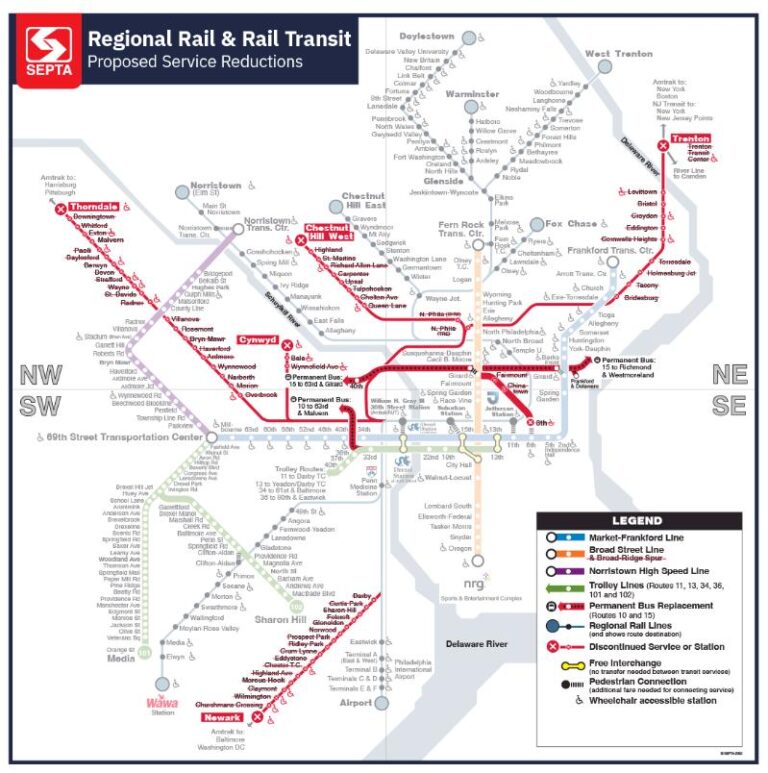Philadelphia’s SEPTA Service Reductions: Navigating Challenges and Community Responses
Concerns Mount as SEPTA Announces Service Reductions Affecting Commuters
Facing ongoing financial constraints, SEPTA has revealed plans to scale back service frequency on several prominent bus and rail lines, igniting apprehension among Philadelphia’s daily transit users. Key routes impacted include some of the busiest arteries connecting Center City with surrounding neighborhoods, where less frequent service could translate into longer waits and more crowded vehicles. Many commuters worry about disruptions to their work routines and personal schedules, highlighting the economic and logistical difficulties that may arise without dependable public transportation.
Meanwhile, local motorists anticipate increased congestion as some riders may shift to private cars in response to diminished transit options. SEPTA officials maintain that these reductions are essential to align operations with current budget realities, yet community leaders and transit advocates are urging the agency to explore alternative strategies that safeguard accessibility and service reliability. Below is an overview of select routes and the proposed frequency changes slated for implementation in the near future:
| Route | Current Frequency | Frequency After Cuts | Impact During Peak Hours |
|---|---|---|---|
| Bus 38 | Every 10 minutes | Every 15 minutes | Moderate |
| Market-Frankford Line | Every 5 minutes | Every 7 minutes | High |
| Regional Rail – Chestnut Hill West | Every 30 minutes | Every 45 minutes | Low |
- Increased waiting periods: Passengers anticipate longer delays during rush hours.
- Higher passenger density: Fewer trips may lead to overcrowded buses and trains.
- Shift to private vehicles: Potential rise in car usage could worsen traffic congestion.
Broader Effects on Philadelphia’s Transit Infrastructure and Neighborhoods
The planned service reductions by SEPTA threaten to disrupt Philadelphia’s broader transportation framework. Riders dependent on public transit are likely to face extended wait times and less frequent service, particularly on vital routes, which may cause overcrowding and strain on the remaining operational lines. Additionally, the anticipated increase in private vehicle use could intensify traffic jams during peak periods, further complicating commutes.
Of particular concern is the impact on neighborhood connectivity, especially in underserved communities where alternative transit options are scarce. This could hinder access to employment, healthcare, and essential services, disproportionately affecting vulnerable populations. The table below highlights some of the most affected routes and neighborhoods:
| Route | Previous Frequency | New Frequency | Neighborhoods Most Impacted |
|---|---|---|---|
| Route 23 | Every 15 minutes | Every 30 minutes | Olney, North Broad |
| Route 47 | Every 20 minutes | Every 40 minutes | South Philadelphia, Point Breeze |
| Route 61 | Every 12 minutes | Every 25 minutes | Chestnut Hill, Germantown |
- Longer travel durations for thousands of daily commuters.
- Greater dependence on cars and ride-hailing services, increasing pressure on city roadways.
- Potential drop in SEPTA ridership, which could jeopardize future transit funding and improvements.
Community Voices Demand Transparency and Inclusive Dialogue
The announcement of service cutbacks has triggered widespread concern among SEPTA riders and employees alike. Many fear that reduced schedules will lead to longer waits, overcrowding, and diminished access—especially for essential workers and those without alternative transportation means. Social media platforms and local forums have become hubs for calls demanding greater transparency from SEPTA leadership regarding the rationale behind the cuts and their expected consequences.
Advocacy organizations have mobilized, hosting public meetings and issuing open letters urging SEPTA to engage in meaningful conversations with the community before finalizing any changes. Key demands include:
- Clear timelines and detailed explanations of the scope of service reductions.
- Guarantees to maintain service on critical routes that serve vulnerable populations.
- Opportunities for public input to influence decision-making.
- Plans to minimize disruptions for daily commuters.
| Stakeholder Group | Primary Concern | Requested Action |
|---|---|---|
| Daily Commuters | Reduced service frequency | Comprehensive schedule details |
| SEPTA Operators | Job security and workload changes | Transparent communication on staffing impacts |
| Community Advocates | Transit accessibility for marginalized groups | Inclusive forums and dialogue sessions |
Proposed Solutions to Alleviate Service Disruptions and Maintain Access
In response to the anticipated challenges, community leaders and transit advocates have outlined several strategies aimed at mitigating the adverse effects of SEPTA’s service cuts. Emphasizing the importance of protecting mobility for low-income residents, seniors, and individuals with disabilities, these recommendations focus on maintaining equitable access to public transportation. Key proposals include:
- Preserving essential bus routes that connect underserved neighborhoods to vital services.
- Enhancing communication efforts to keep the public informed about changes and alternative options.
- Forging partnerships with ride-share companies to provide subsidized transportation during periods of reduced service.
- Launching pilot programs for demand-responsive transit, allowing flexible service adjustments based on real-time rider needs.
Complementing these community-driven initiatives, data-driven impact assessments can help policymakers identify the most vulnerable service areas and prioritize interventions. The table below outlines projected ridership declines and suggested mitigation measures by region:
| Region | Estimated Ridership Decline | Recommended Mitigation Strategy |
|---|---|---|
| South Philadelphia | 15% | Maintain peak-hour service levels |
| West Philadelphia | 12% | Introduce shuttle connections to key hubs |
| Northeast Philadelphia | 10% | Expand community outreach and support programs |
Looking Ahead: Navigating the Future of Philadelphia’s Public Transit
As SEPTA advances with its proposed service reductions, uncertainty looms for both riders and transit employees regarding the future of daily commutes. While the authority aims to address pressing budgetary and operational challenges, the potential consequences for accessibility and convenience continue to raise alarms within the Philadelphia community. Officials have committed to incorporating public feedback before finalizing any adjustments, underscoring the importance of ongoing engagement.
Stakeholders and commuters are encouraged to remain involved as the situation evolves, with further updates expected in the coming weeks. The path forward will require balancing fiscal responsibility with the critical need to maintain a transit system that supports the city’s diverse population and economic vitality.






